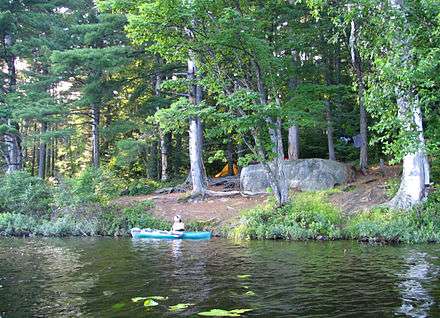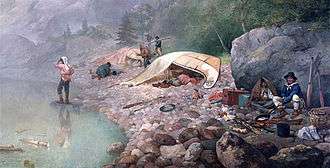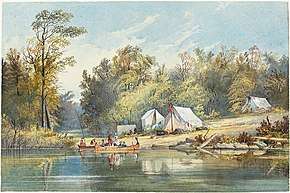Canoe camping
Canoe camping, also known as touring, tripping or expedition canoeing, is a combination of canoeing and camping. Like backpacking, canoe campers carry enough with them to travel and camp for several days, but do so via a canoe or kayak.

Description
A canoeist can transport significantly heavier and bulkier loads than a backpacker or even a kayaker can. Portaging by foot is sometimes necessary to pass between water bodies or around hazardous obstacles such as rapids or waterfalls, but most of the time canoe campers travel on water. Because they usually don't continuously carry their gear on their backs, canoe campers can bring more food and gear and undertake longer trips. This is especially the case with food which, unlike gear where the weight is essentially fixed regardless of the trip duration, increases in weight for each additional day of provision. On rivers, high water levels after storms can make river travel hazardous, while on lakes, winds and thunderstorms can produce strong winds which create large waves and headwinds which work against paddlers to slow the canoe. Trips may need to have extra days built into the schedule in case of weather delays.
Although some experienced canoeists feel comfortable paddling straight through large bodies of water, most typically stay within a few hundred meters of shore. Since a fully loaded touring canoe only draws about 14 cm (six inches), it can approach a rocky shore as close as arm's-length. This proximity (and a canoe's inherent quietness) lets the canoeist observe aquatic and near-shore plants and wildlife from a perspective that walking on solid ground does not allow. Many people engage in fishing while canoe camping.
The versatility of canoe tripping allows canoeists to go places and see things that they otherwise could not.
Many canoeists use specialized canoe packs designed for both easy portaging and loading into canoes. Waterproof dry bags are frequently used to keep important items dry in case of inclement weather or capsizing.
History


Native Americans of many different tribes who used canoes for transportation, needed to "canoe camp" regularly. Before the construction of modern means of transportation and transportation routes, the most effective way to travel through the vast expanses of northern wilderness was to navigate the countless small waterways by canoe. Their canoe was perfect for this purpose, as it was relatively easy to carry, fast, able to traverse a wide variety of different water ways (small streams to huge lakes), and able to carry large loads.
It was for all these reasons that the early French explorers of North America, such as Louis Jolliet, quickly adopted the use of the Native American canoe. With them came Jesuit missionaries, coureurs des bois, and voyageurs. Once trading posts were established in the interior, the canoe continued to be the primary transportation method, supplying such posts with regular canoe brigades. In northern Quebec, this practice continued until the middle of the 20th century.
As the "wilderness" of the Americas was tamed by the construction of the railroad and later roads, the canoe as a means of primary transportation lost its practicality. It turned into a recreational sport, a way for Americans and others to experience the pre-European America, and have a glimpse of a formerly never-ending wilderness. While recreational canoe camping has been enjoyed since the late 19th century by sporting and boating enthusiasts, it was not until later in the 20th century that, with the advent of camping consumer goods, it gained mass appeal.
The history of the Grand Portage, MN is an excellent metaphorical microcosm for the larger change and the eventual invention of the idea of "canoe camping"… for fun.
Notable proponents and expeditions
An early proponent and popularizer of canoe camping was George W. Sears, a sportswriter for Forest and Stream magazine in the 1880s, whose book Woodcraft (1884), told the story of his 1883, 266-mile (428 km) journey through the central Adirondacks in a 9-foot-long (2.7 m), 10 1⁄2-pound (4.8 kg) solo canoe named the Sairy Gamp. He was 64 years old and in frail health at the time.
Also in 1883, American Canoe Association Secretary Charles Neide and retired sea captain "Barnacle" Kendall paddled and sailed over 3,000 miles (4,800 km) in a sailing canoe from Lake George, New York to Pensacola, Florida.
The adventure memoir Canoeing with the Cree relates Eric Sevareid's youthful journey with a companion from Minnesota to Hudson Bay in 1930.
In Canada, Bill Mason, who was an author, artist, filmmaker, and environmentalist, published several books and produced a number of films in the 1970s that greatly advanced the popularity of canoe camping.
Calvin Rutstrum was a wilderness canoeist and author, whom Bill Mason said "totally influenced me" and "he became my hero".[1]
Like Mason and Sevareid, a number of modern-day canoeists have retraced the historic routes of the fur-traders and voyageurs and published books about their experiences. Noteworthy examples from Canada include "Coke Stop in Emo: Adventures of a Long-Distance Paddler" by Alec Ross, "Canoeing a Continent: On the Trail of Alexander MacKenzie" by Max Finkelstein and "Where Rivers Run" by Joanie and Gary McGuffin.
Sigurd Olson, conservationist and north woods writer, traveled and camped by canoe extensively. These included long trips as he wrote about in his book The Lonely Land and well as frequent shorter trips covered in many of his books.
Eric W. Morse, author, historian and notable wilderness canoe tripper traveled with Sigurd Olson. He authored books on their wilderness trips and on historical fur trade canoe routes in Canada. [2]
In the "Source to Sea expedition" of 2005, two students from North Carolina State University paddled 2,150 miles (3,460 km) down the Mississippi and Atchafalaya Rivers to support the Audubon Society's Upper Mississippi River Campaign.
The book New York to Nome by Rick Steber details the story of Sheldon Taylor and Geoffrey Pope who paddled from New York City April 25, 1936 to Nome, Alaska August 11, 1937. This is the longest recorded canoe trip in history (1974 Guinness Book of World Records)
Henry David Thoreau, an American author and advocate of environmental conservation, provided a written account of a long distance canoeing expedition in his book The Maine Woods. Thoreau's canoeing expedition in Maine covered remote areas that can still be experienced in Maine's Hundred Mile Wilderness.
Popular destinations
Australia
Canada
- Algonquin Provincial Park, Ontario
- Bowron Lake Provincial Park, British Columbia[3]
- Churchill River, Saskatchewan and Manitoba
- George River, Nunavik, Quebec
- Kejimkujik National Park, Nova Scotia
- Killarney Provincial Park, Ontario
- Lakeland Provincial Park & Recreation Area, Alberta[4]
- La Vérendrye Wildlife Reserve, Quebec
- McLennan Lake, Saskatchewan[5]
- Main Lake Canoe Route, Quadra Island, British Columbia
- Manigotagan River, Manitoba
- Missinaibi River, Ontario
- Moisie River, Quebec
- Nitinat Triangle, British Columbia[6]
- Nopiming Provincial Park, Manitoba
- Quetico Provincial Park, Ontario
- Powell Forest Canoe Route, Powell River, British Columbia [7]
- Sayward Forest Canoe Route, British Columbia[8]
- Nahanni River, North West Territories
- Temagami area including Lake Temagami and Lady Evelyn-Smoothwater Provincial Park, Ontario
- Whiteshell Provincial Park, Manitoba
Germany
- Mecklenburg Lake District, Mecklenburg-Vorpommern
Hungary
- Bodrog River, Borsod-Abaúj-Zemplén County
- Hernád River, Borsod-Abaúj-Zemplén County
- River Ipoly, Nógrád County and Pest County
- Rába River, counties of Vas and Győr-Moson-Sopron
- Sajo River, Borsod-Abaúj-Zemplén County
- Tisza River
New Zealand
Poland
- Obra, Lubuskie
- Krutynia
- Czarna Hańcza
- Brda
- Pilica
United States
- The Boundary Waters Canoe Area Wilderness, Minnesota
- Voyageurs National Park, Minnesota
- Everglades National Park, Florida
- Ross Lake, North Cascades, Washington state
- Saint Regis Canoe Area, Adirondack Mountains, New York
- Northern Forest Canoe Trail, Old Forge, New York to Fort Kent, Maine
- Ozark National Scenic Riverways, Missouri
- Green River, Utah
References
- Wilderness Visionaries by Dale Vickery 1986 North Woods Press Inc. ISBN 1-55971-435-2 Chapter 5
- Canadian Geographic magazine web site Retrieved 11/18/13 "From the archives" box gives 1977 date for Canadian Geographic article. "In 1977, canoeing pioneer Eric W. Morse described in the Canadian Geographical Journal the history of utilitarian and recreational canoeing in Canada. After the First World War, writes Morse, two-thirds of Canadians lived in cities, giving the wilderness—and canoeing—a new purpose. “[T]he wilderness instead of being hated and feared had come to have a new, escape value,” he writes, “and the canoe remained the best way to penetrate it.”" http://www.canadiangeographic.ca/magazine/ja12/canoeing2.asp Archived 2013-10-29 at the Wayback Machine
- Bowron Lake Provincial Park - BC Parks
- Back Country Canoe Circuit
- "University of Calgary Recreation, Fitness, and Outdoor Programs". Archived from the original on 2012-12-24. Retrieved 2012-08-01.
- "Nitnat Triangle canoe circuit". Archived from the original on 2013-01-15. Retrieved 2012-08-01.
- Sayward Forest Canoe Circuit: Amazon.ca: Michel Gauthier: Books
Further reading
- Bill Mason, Song of the Paddle: An Illustrated Guide to Wilderness Camping, Firefly Books, 1988. ISBN 978-1552090893
- Eric W. Morse, Freshwater Saga, Northword Press, July 1987. ISBN 978-0942802559
- Sigurd F. Olson, The Lonely Land, New York, 1961. ISBN 978-0816629978
External links
| The Wikibook Adventist Youth Honors Answer Book has a page on the topic of: Canoe trip |